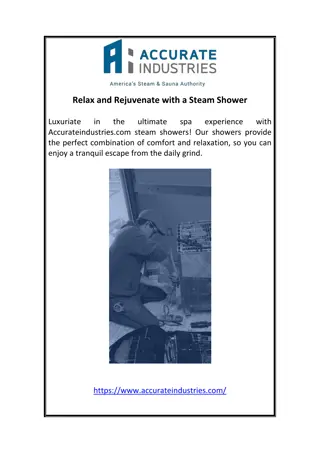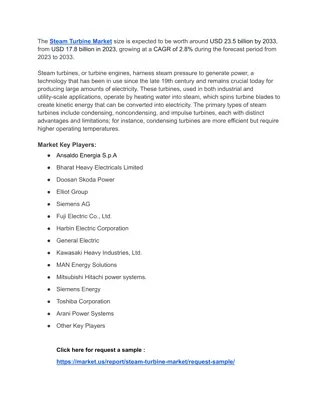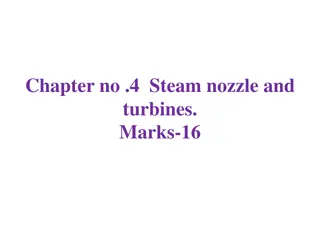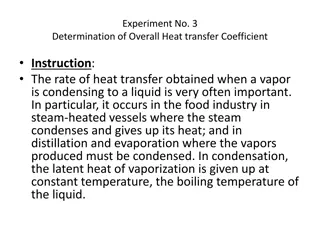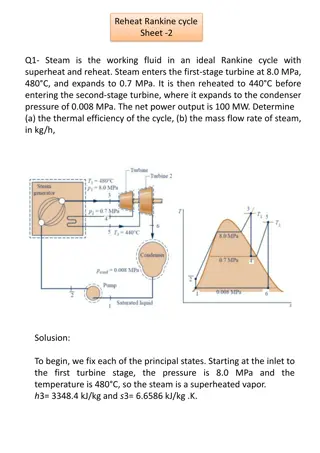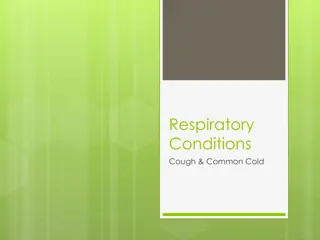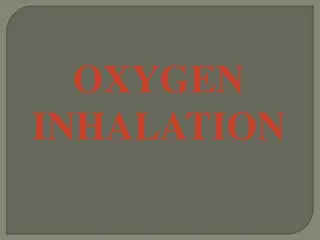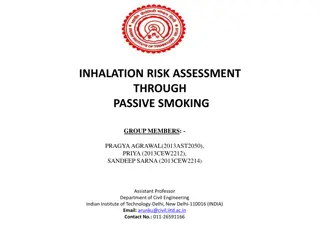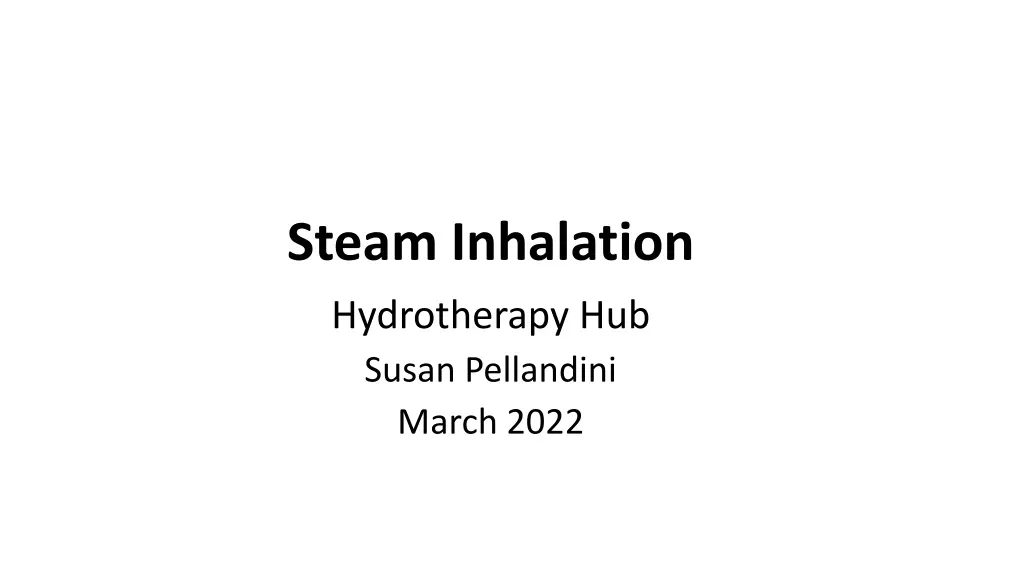
Steam Inhalation Therapy Benefits
Discover the therapeutic benefits of steam inhalation therapy, an ancient remedy for respiratory issues. Learn how to perform safe and effective treatments using simple at-home tools. Explore the physiological effects, indications, and herbal enhancements of steam inhalation for respiratory health and skin rejuvenation. Enhance your understanding of this natural therapy with detailed module objectives and visual aids.
Download Presentation

Please find below an Image/Link to download the presentation.
The content on the website is provided AS IS for your information and personal use only. It may not be sold, licensed, or shared on other websites without obtaining consent from the author. If you encounter any issues during the download, it is possible that the publisher has removed the file from their server.
You are allowed to download the files provided on this website for personal or commercial use, subject to the condition that they are used lawfully. All files are the property of their respective owners.
The content on the website is provided AS IS for your information and personal use only. It may not be sold, licensed, or shared on other websites without obtaining consent from the author.
E N D
Presentation Transcript
Steam Inhalation Hydrotherapy Hub Susan Pellandini March 2022
Steam Inhalation As mentioned in an earlier chapter, steam baths and breathing steam has been a sought-after remedy in many cultures and to some, considered a luxury. Steam inhalation or breathing warm-hot steam is just about the easiest and effective treatment. Breathing steam moistens, soothes and warms the upper respiratory tract, loosens clogged mucous, vasodilates tissue and clears nasal passages. No elaborate equipment is needed. A clean bowl with hot, steaming water and a towel to trap the steam can be found in virtually every home.
Steam Inhalation Fresh or dried herbs as well as essential oils have traditionally been added to the steaming water to ease inflammation and prevent bacterial growth. It is not uncommon for dermatologists and estheticians to use steam therapy prior to facials and skin treatments. Steam opens the pores of the skin to release toxins or receive salves and ointments nutritive elements for health and healing.
Steam Inhalation MODULE OBJECTIVES After completing this module and Life and Health Hydrotherapy Videos Section 3.4 the student will be able to: Explain the physiological effects of localized steam inhalation therapy. Identify cautions and contraindications of steam inhalation. Be able to perform safe and effective steam inhalation treatment.
Steam Inhalation Definition Directed water vapor from a source of boiling or steaming water to the nose and mouth area. The act of breathing water vapor to treat nasal or upper respiratory congestion, irritation or dryness.
Steam Inhalation Physiological Effect 1. Keep nasal mucous membranes from excessive drying. 2. Loosens secretions and stimulate discharge of mucous from the lungs, throat, upper respiratory passages. 3. Relieve spasmodic breathing in throat and sinuses (asthma, allergies). 4. Relieve upper respiratory tract from irritating substances, air, inflammation and congestion.
Steam Inhalation Indications 1. Coughing. 2. Congestion in lungs, nose, throat, or sinuses. 3. Throat irritation or dry mouth. 4. Irritations from allergies (relieve symptoms). 5. Loosen dry or thick secretions in respiratory tract.
Steam Inhalation Contraindications / Precautions 1. Extreme young children or the very elderly who may not be able to respond to heat. 2. Clients with severely compromised cardiovascular systems or CHF may find humid air hard to breathe. 3. Avoid burning clients. Latent heat in steam burns quickly.
Steam Inhalation Equipment (have all ready prior to treatment) 1. Heat source (hot plate, stove top, rice cooker, bowl of extremely hot water. You can also use a portable steam inhaler purchased at local drug store). 2. Pot of water half full if using hot plate or stove top. 3. Essential oil of eucalyptus or pine (using 1 drop is optional). 4. Large towel to drape over head and trap vapor.
Steam Inhalation Equipment, continued 5. Dishpan of cold ice water with washcloth. 6. Shower cap (optional) 7. Extension cord if using hot plate or rice cooker. 8. BP monitor, health history forms, treatment forms. 9. Prayer.
Steam Inhalation Procedure 1. Choose heat source and pre-heat accordingly. 2. If using essential oil add 1-2 drops in hot water. 3. Explain treatment to client, clearing for precautions & take vital signs. 4. Have client remove eye glasses & jewelry, if applicable. 5. Provide shower cap to keep humidity from hair if client prefers. 6. Pray with client. 7. Instruct client to lean over heat source as they hold towel over head, including heat source to trap the vapor.
Steam Inhalation Procedure, continued 8. Instruct client to breathe deeply and slowly as they are able. 9. Keep heat source simmering through out duration of treatment. 10.Be cautious so as not to burn client. 11.Continue for up to 20 minutes. 12.Remove heat source and cool face with wash cloth for 30 sec. 13.Record treatment. 14.Repeat treatment every 3-4 hours while symptoms last.
Steam Inhalation The Steam Inhaler is a handy device for breathing hot steam. It s compact which makes it easy for packing into suitcase and travel. An extension cord may be needed to reach electrical outlet. Thoroughly disinfect between uses individuals. and different https://www.amazon.com/Vicks-Personal-V1200-Targeted- Congestion/dp/B0000TN7MY/ref=sr_1_7?crid=3VHGC0DAZ9OF I&keywords=steam+inhalation+machine&qid=1645157453&spr efix=steam+inhala%2Caps%2C108&sr=8-7
Steam Inhalation Be sure to thoroughly disinfect all hard surfaces. Spray bowl or steam unit. Wipe out residue and spray again. Wash linens in hot water.
References Sinclair, Marybetts, Modern Hydrotherapy for the Massage Therapist, Chapter 8, Lippincott Williams & Wilkins, 2008



